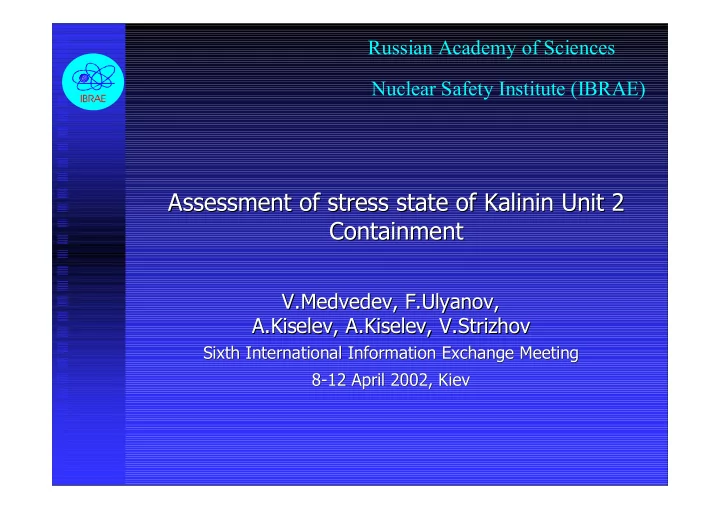

Russian Academy of Sciences Nuclear Safety Institute (IBRAE) Assessment of stress state of Kalinin Kalinin Unit 2 Unit 2 Assessment of stress state of Containment Containment V.Medvedev Medvedev, F. , F.Ulyanov Ulyanov, , V. A.Kiselev Kiselev, A. , A.Kiselev Kiselev, V. , V.Strizhov Strizhov A. Sixth International Information Exchange Meeting Sixth International Information Exchange Meeting 8- -12 April 2002, Kiev 12 April 2002, Kiev 8
Computer Code CONT I Designed for numeric simulation of concrete Designed for numeric simulation of concrete I containment behavior under quasi- -static operational static operational containment behavior under quasi and accident loads and accident loads I Program capabilities: Program capabilities: I N Non Non- -linear elastic and plastic problems linear elastic and plastic problems N N Reinforcement and Reinforcement and prestressing prestressing N N Cracking of concrete Cracking of concrete N N Temperature distribution Temperature distribution N I Realization Realization: : I N 2D Axial symmetry model 2D Axial symmetry model N N 3D model with the use of 3D model with the use of superelements superelements N I Certified in the Certified in the Gosatomnadzor Gosatomnadzor of RF of RF I
CONT Code Verification I Verification against analytical problems I Validation against experimental data: N Small scale model experiments conducted in Russia N 1:6 Sandia reinforced containment test N 1:4 Sandia prestressed containment tests (in progress) I Comparison to NPP data ( Comparison to NPP data (Kalinin Kalinin VVER VVER- -1000) 1000) I
Kalinin-2 NPP Containment Main Geometrical parameters Main design peculiarities of Main design peculiarities of I I the containment the containment Geometry of the containment Geometry of the containment N N Reinforcement Reinforcement N N Presstressing system system Presstressing N N Methodology of analysis for Methodology of analysis for I I prestressed concrete prestressed concrete containment containment Nodalization scheme of the scheme of the Nodalization I I containment containment Results of the analysis under Results of the analysis under I I normal operation and normal operation and accident conditions accident conditions
Computational model of the Kalinin Unit-2 Containment The computational The computational model includes model includes 67946 finite elements 67946 finite elements and 76014 nodes and 76014 nodes
Computational model of the concrete wall 1 – – metallic liner metallic liner 1 I I 2, 4, 6, 7, 9, 11 – – concrete concrete 2, 4, 6, 7, 9, 11 I I layers layers 3, 10 – 3, 10 – meridian meridian I I reinforcement reinforcement 5, 8 – 5, 8 – hoop reinforcement hoop reinforcement I I
Scheme of the reinforcement in the middle of cylindrical part of containment .
Location of tendons in the cylindrical part of Kalinin-2 containment
Methodology of analysis Factors considered: Loads considered: I Concrete cracking in I Tendons prestressing case of reaching I Inherent weight of ultimate stretching containment strengths I Thermostresses due to I Presence of internal non-steady state metallic liner temperature gradients I Concrete reinforcement under operational and including its accident conditions strengthening in the I Variation of internal areas of stress pressure in course of concentration accident
Peculiarities of simulation prstressing of tendons I Real tendons trajectories I Strength reduction along tendons due to friction I Strength reduction from the jack to anchor I Real strength of tendons according to plant data
Stresses in liner (internal surface) and concrete (outer surface) due to inherent weight (MPa) Meridian stresses (SM) Hoop stresses (ST) Meridian stresses (SM) Hoop stresses (ST)
Defornmation of containment due to prestressing of tendons I Real strengths in tendons were applied I Scale factor for deformations 500
Meridian stresses in the concrete due to prestressing of tendons
Hoop stresses in the concrete due to prestressing of tendons
Stresses in liner (internal surface) and concrete (outer surface) due to internal pressure 1 MPa Meridian stresses (SM) Hoop stresses (ST) Meridian stresses (SM) Hoop stresses (ST)
Temperature distribution in the concrete in normal operation conditions Inside temperature +40 °С Outside temperature –20 °С
Stresses in liner (internal surface) and concrete (outer surface) due to operational temperature Meridian stresses (SM) Hoop stresses (ST) Meridian stresses (SM) Hoop stresses (ST)
Calculated temperature variation at different location in the time interval between 13.09.99 through 29.12.99 at different depths 50 Облицовка (внутре нняя Air temperature inside Internal reinforcement пове рхность) Liner Внутре нняя арма тура 40 Сре динный слой Наружна я а рма тура 30 Наружна я пове рхность 1507 Middle reiforcement 20 1508 Temperature, C 1509 10 2501 2502 0 2503 0 200 400 600 800 1000 1200 1400 1600 1800 2000 2200 2400 2600 2800 3000 3505 Air tempera ture outside -10 Outer reinforcement 3506 3507 Outer surface -20 T-сре ды внутри T-спе ды сна ружи -30 Time , hr
Temperature distribution through containment wall on 29.12.1999 with the account of inside and outside temperature variations
Hoop stresses in the concrete due to temperature gradients
Variation of temperature and pressure in the containment for design accident t - time (hr) from accident
Stresses in liner (internal surface) and concrete (outer surface) due to operational temperature Meridian strength (SM) Hoop strength (ST) Meridian strength (SM) Hoop strength (ST)
Meridian and hoop strength [MN] in the horizontal sections, Z=25 m (a) и Z=60.5 m (b) at the initial time instant b) a) a)
Conclusions I The state of the Kalinin Unit 2 containment is at the reasonable level under actual strength (800 tones) both for operational and accident conditions I The CONT code allows to account for a number of factors influencing stress-strain state of the containment under operational and accident loads I Assessments performed with the CONT code allows to develop methodology of operational safety control accounting for actual state of prestressing tendons which require strengthening to recover necessary prestressing level
Recommend
More recommend